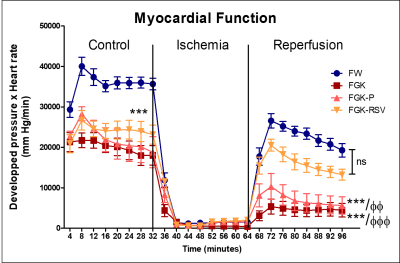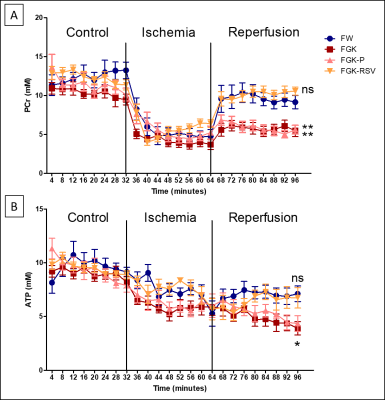2956
Protective effect of Resveratrol against cardiac dysfunction and impaired energy metabolism of type 2 diabetic female GK rat heart submitted to Ischemia-Reperfusion injury1Aix Marseille Univ, CNRS, CRMBM, Marseille, France, 2Aix-Marseille Univ, UMR Inserm 1062/ INRA 1260, NORT, Marseille, France, 3YVERY sarl, Marseille, France
Synopsis
Type 2 diabetes doubles the risk of myocardial infarction in women. New treatments need to be found to reduce cardiovascular mortality. Consequently, we investigated the effect of Resveratrol (RSV) on the tolerance to ischemia-reperfusion (IR) injury of type 2 diabetic female Goto-Kakizaki (GK) rat heart. We used a multiparametric approach allowing simultaneous measurement of cardiac function, energy metabolism by 31P MRS and endothelial function. Oral RSV treatment improved myocardial performance, coronary flow and energy metabolism during reperfusion in GK rats. Consequently, RSV might be an interesting therapeutic approach to improve survival to myocardial IR injury of type 2 diabetic women.
Introduction:
Type 2 diabetic women have greater risk of mortality by cardiovascular (CV) disease than non-diabetic women. Particularly, type 2 diabetes (T2D) doubles the risk of myocardial infarction in women, but involved mechanisms are still not clear1. Today anti-diabetic treatments allow a reduction in blood glucose but do not decrease patient’s CV mortality, therefore new treatments need to be found. Resveratrol (RSV) is a polyphenol found in grapes reported to be beneficial on oxidative stress, endothelial dysfunction and inflammation involved in CV complications of T2D2. Consequently, we have investigated the effect of RSV on the tolerance to ischemia-reperfusion (IR) injury of type 2 diabetic female Goto-Kakizaki (GK) rat hearts by using multiparametric approach allowing simultaneous measurement of cardiac function, energy metabolism and endothelial function.Methods:
8-month-old female GK (FGK) rats3,4 and their age-matched respective control female Wistar (FW, n=11) were used. FGK were divided in three groups: one without treatment (FGK-0, n=14); one with RSV (FGK-RSV, n=8) at the dose of 1 mg/kg/day5 in drinking water for 8 weeks; and one with Placebo (FGK-P, n=9). Then, isolated rat hearts were perfused (Figure 1) with 0.4 mM palmitate, 3% albumin, 11 mM glucose, 3U/L insulin, 0.8 mM lactate and 0.2 mM pyruvate for 24 minutes before switching to 1.2 mM palmitate for 32 minutes low-flow (0.5 mL/min/g wet wt) ischemia. Next, flow was restored with 0.4 mM palmitate buffer for 32 minutes. High-energy phosphates and intracellular pH were measured during the experimental course by 31P magnetic resonance spectroscopy with simultaneous measurement of contractile function. Coronary flow was measured before and after ischemia. Glucose and free fatty acids (FFA) were measured in plasma. Nitric oxide and Sirtuin pathways were studied in freeze-clamped tissues at the end of experiments. Creatine kinase and lactate dehydrogenase activities were also used as markers of myocardial damage.Results:
Glucose was significantly higher in FGK vs. FW (p<0.0001) while FFA were similar in the four groups. Heart to body weight ratio was also significantly higher in FGK vs. FW indicating cardiac hypertrophy (p<0.0001). Before ischemia, Rate Pressure Product (RPP), index of cardiac performance, was significantly lower in FGK vs. FW (p<0.0001), indicating an impaired cardiac function that was not improved by treatment with RSV (Figure 2). During reperfusion, RPP was significantly lower in FGK-0 and in FGK-P vs. FW (p<0.001), whereas RSV treatment completely restored cardiac function during reperfusion in FGK-RSV (ns vs. FW). Moreover, myocardial energy metabolism (Figure 3) was similar in the four groups in baseline conditions. However, after ischemia, PCr and ATP levels were significantly decreased in both FGK-0 and FGK-P groups (respectively p<0.01 and p<0.05 vs. FW) and RSV treatment restored PCr and ATP levels in FGK-RSV to control values (ns vs. FW). Finally, baseline coronary flow was similar in the four groups but during reperfusion, coronary flow was impaired in FGK-0 and FGK-P groups vs. FW (respectively p<0.001 and p<0.01), whereas RSV significantly re-established coronary flow in FGK-RSV to control values (ns vs. FW).Discussion and conclusion:
Female type 2 diabetic GK rat hearts exhibit greater sensitivity to IR injury characterized by a decrease of cardiac and endothelial functions associated with impaired energy metabolism. Oral 8-weeks treatment with RSV improved myocardial performance, coronary flow and energy metabolism during reperfusion. Consequently, RSV might be an interesting therapeutic approach to improve survival to myocardial IR injury of type 2 diabetic women. Further work is in progress in order to understand the molecular mechanisms involved in cardioprotective effects of RSV.Acknowledgements
This work was supported by CNRS, Aix-Marseille Université and France Life Imaging.References
1S.G. Wannamethee et al., “Do women exhibit greater differences in established and novel risk factors between diabetes and non-diabetes than men?” Diabetologia, (2012) 55:80-87.
2M.J. Amiot et al., “Optimization of trans-Resveratrol bioavailability for human therapy", Biochimie, (2013) 95:1233-8.
3Y. Goto et al., “Spontaneous diabetes produced by selective breeding of normal Wistar rats”, Proceedings of Japan Academy, (1975) 51:80-85.
4Portha et al., “The GK rat: a prototype for the study of non-overweight type 2 diabetes”, Methods Mol Biol, (2012) 933:125-59.
5K.K.R. Rocha et al., “Resveratrol toxicity: Effects on risk factors for atherosclerosis and hepatic oxidative stress in standard and high-fat diets”, Food and chemical toxicology, (2009) 47:1362-1367.
Figures


